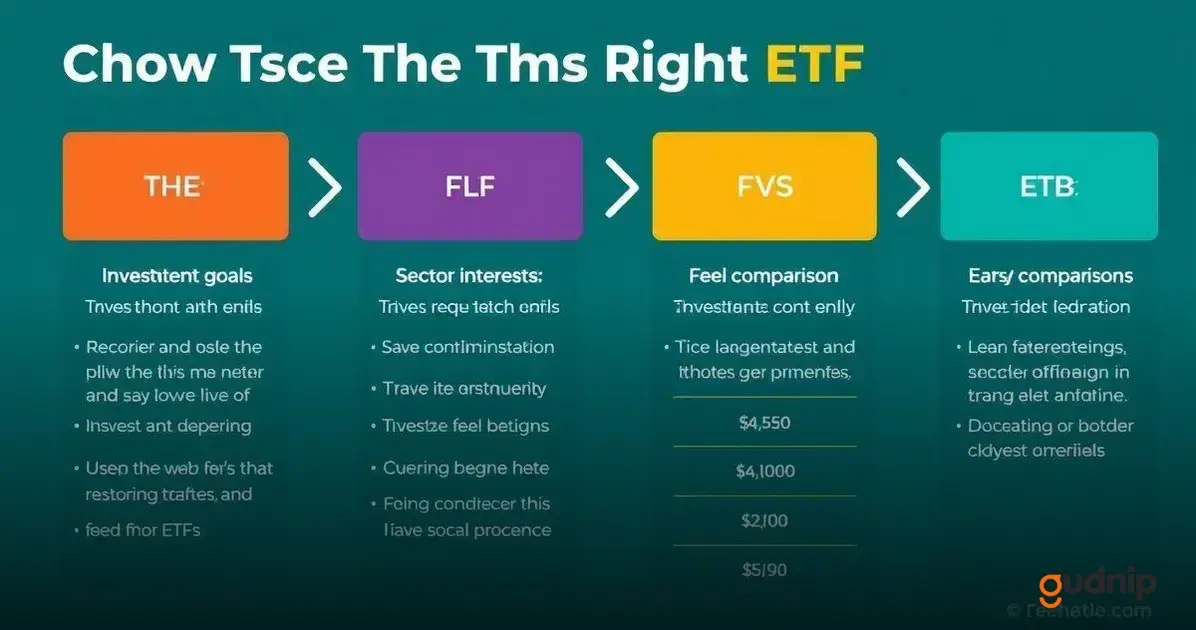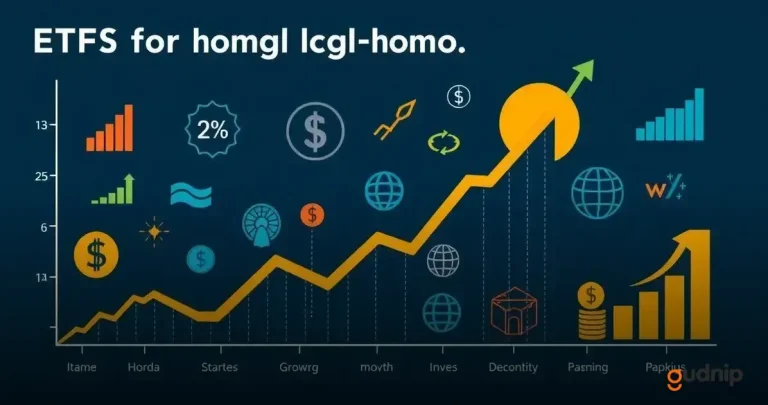Investing in top ETFs for long-term growth is a smart strategy for building wealth over time.
With the right selection, your investments can perform exceptionally well, taking advantage of market trends and economic growth.
Understanding ETFs and Their Benefits
ETFs, or Exchange-Traded Funds, provide a simple way to invest in a variety of assets.
They are like baskets of stocks or bonds that you can buy and sell on a stock exchange. This makes them easy to trade, similar to buying a single stock.
With ETFs, you can spread your money across many different investments, which helps reduce risk.
One of the biggest benefits of ETFs is their low cost.
Many have lower fees compared to mutual funds, making them a great choice for budget-conscious investors.
This means more of your money goes towards growing your investments.
Plus, they can be bought and sold throughout the day, giving you flexibility in how you manage your portfolio.
Investing in ETFs can lead to good long-term growth as they track the performance of a market index or sector.
This means that as the market grows, your investments can grow too.
Whether you’re a beginner or an experienced investor, understanding how ETFs work can help you make smart decisions and build a strong, diverse portfolio for the future.
Why Choose Long-Term Growth ETFs?
Choosing long-term growth ETFs is a smart way to invest your money for the future.
These ETFs focus on companies that are expected to grow over time, which means your investment has the potential to increase in value significantly.
By selecting these types of funds, you’re putting your money into businesses that are likely to succeed in the long run, making them a great option for building wealth.
Long-term growth ETFs are also less stressful for investors.
Since they aim for growth over years rather than quick gains, you don’t have to worry as much about daily market swings.
This allows you to hold onto your investments and watch them grow at a steady pace.
It helps you stay focused on your financial goals rather than reacting to short-term market changes.
Another reason to choose these ETFs is their diversification.
By investing in a mix of different companies across various sectors, long-term growth ETFs spread out your risk.
This means that if one company doesn’t perform well, others in the fund might do better, balancing out your overall investment.
This strategy can set you up for better returns while keeping your investment safer.
Top 5 ETFs for Long-Term Growth in 2023
In 2023, several ETFs stand out for those looking to invest in long-term growth.
The first is the Vanguard S&P 500 ETF (VOO).
This ETF tracks the performance of the S&P 500, which means it invests in 500 of the largest companies in the U.S.
It’s a great choice for investors seeking steady growth as it reflects the overall performance of the market.
Another strong contender is the iShares Russell 2000 ETF (IWM). This ETF focuses on smaller companies that are part of the Russell 2000 index.
Investing in smaller companies can lead to significant growth as they often have more room to expand.
This makes IWM an exciting option for long-term investors wanting to capture that growth potential.
Finally, the Fidelity MSCI Information Technology Index ETF (FTEC) is an excellent choice for those interested in the tech sector.
Technology is a rapidly growing field, and this ETF allows you to invest in major players in the industry.
By choosing FTEC, you can tap into the growth of innovative technologies while keeping your investment diversified.
How to Choose the Right ETF for You

Choosing the right ETF starts with understanding your investment goals. Ask yourself what you want to achieve with your investments.
Are you looking for steady growth, income, or a mix of both? By defining your goals, you can narrow down which ETFs align with your long-term strategy.
Knowing your risk tolerance is also key; some ETFs focus on aggressive growth while others are more conservative.
Next, consider the types of sectors or industries you are interested in.
If you are excited about technology, look for ETFs that track tech companies.
If you prefer stability, consider those that invest in established businesses or dividends.
Research the different options to find an ETF that matches your interests and fits your overall portfolio.
Finally, be sure to examine the fees and expenses related to the ETFs you consider. Lower fees can lead to better returns over time.
Look for ETFs with expense ratios that are competitive.
Remember, investing wisely is not just about choosing the right funds but also about managing your costs effectively to maximize your growth.
Tips for Investing in Long-Term Growth ETFs
When investing in long-term growth ETFs, the first tip is to stay focused on your goals.
It’s important to remember that these investments are meant for the long haul.
Avoid the temptation to sell when the market fluctuates; instead, stay patient and stick to your investment strategy.
This long-term view can help you take advantage of the market’s overall growth.
Another key tip is to regularly review your portfolio. While long-term growth is the aim, it’s still vital to check on your investments annually.
This allows you to assess whether your ETFs are still aligned with your goals.
Make adjustments if necessary, but ensure they’re based on data and trends rather than emotions or short-term market noise.
Lastly, consider reinvesting your dividends. Many long-term growth ETFs pay dividends, which can boost your overall returns.
Instead of cashing out your dividends, use them to buy more shares of your ETFs.
This strategy can help you grow your investment faster over time, allowing the power of compounding to work in your favor.
Common Mistakes When Investing in ETFs
One common mistake when investing in ETFs is not researching the fund’s holdings.
Many investors buy ETFs without fully understanding what companies or sectors they’re invested in.
This can lead to surprises if the market shifts and you own a fund that performs poorly.
Always take the time to learn about the underlying assets and ensure they align with your investment goals.
Another mistake is misunderstanding the difference between trading and investing.
Some people treat ETFs like stocks, buying and selling them frequently based on market trends.
This strategy can be risky and may lead to missing out on long-term growth.
Instead, focus on a buy-and-hold approach to capture the full potential of your investments over time.
Finally, ignoring costs is a common pitfall. Even small fees can add up over time and reduce your overall returns.
Be sure to compare expense ratios and understand any additional costs associated with trading ETFs.
Selecting low-cost options can significantly boost your earnings as you invest for the long term.
Future Trends in ETF Investments
One future trend in ETF investments is the rise of thematic ETFs.
These funds focus on specific themes or trends, such as clean energy or technology innovation.
Investors are increasingly interested in these specialized funds as they can capitalize on specific growth areas.
As the world evolves, thematic ETFs allow individuals to invest in sectors they believe will thrive in the future.
Another trend is the growth of actively managed ETFs.
Traditionally, most ETFs are passively managed, but more investors are looking for funds that have a management team making decisions based on market analysis.
Actively managed ETFs can offer the potential for higher returns by adapting more quickly to changing market conditions, giving investors more options for their portfolios.
Finally, we can expect to see increasing focus on sustainability and ESG (Environmental, Social, and Governance) criteria in ETFs.
Investors today are more conscious of their impact on the world and seek to invest in companies that align with their values.
Funds that prioritize ESG factors are likely to gain popularity, leading to a more socially responsible investment landscape.
ETFs and Investing
What are ETFs?
ETFs are investment funds that are traded on stock exchanges, much like stocks.
Why are ETFs popular among investors?
ETFs offer flexibility, lower fees, and the ability to diversify investments easily.
What types of themes do thematic ETFs focus on?
Thematic ETFs focus on specific themes like technology or renewable energy.
How do ETFs help in reducing risk?
By allowing investors to hold a variety of stocks or bonds, ETFs help reduce risk while providing growth opportunities.
What advantage do ETFs have over mutual funds?
ETFs generally have lower fees compared to mutual funds.
Can you adjust investments easily with ETFs?
Yes, ETFs can be traded like stocks, making it easier to adjust investments based on market changes.





